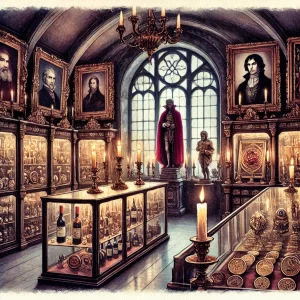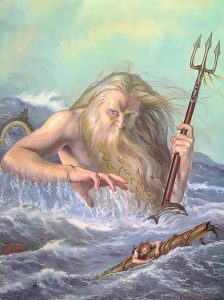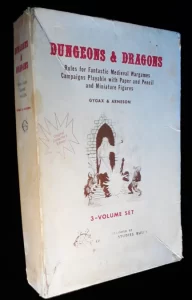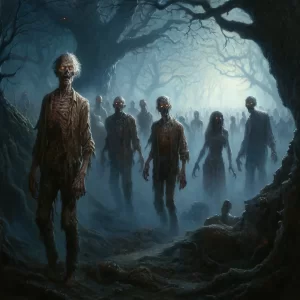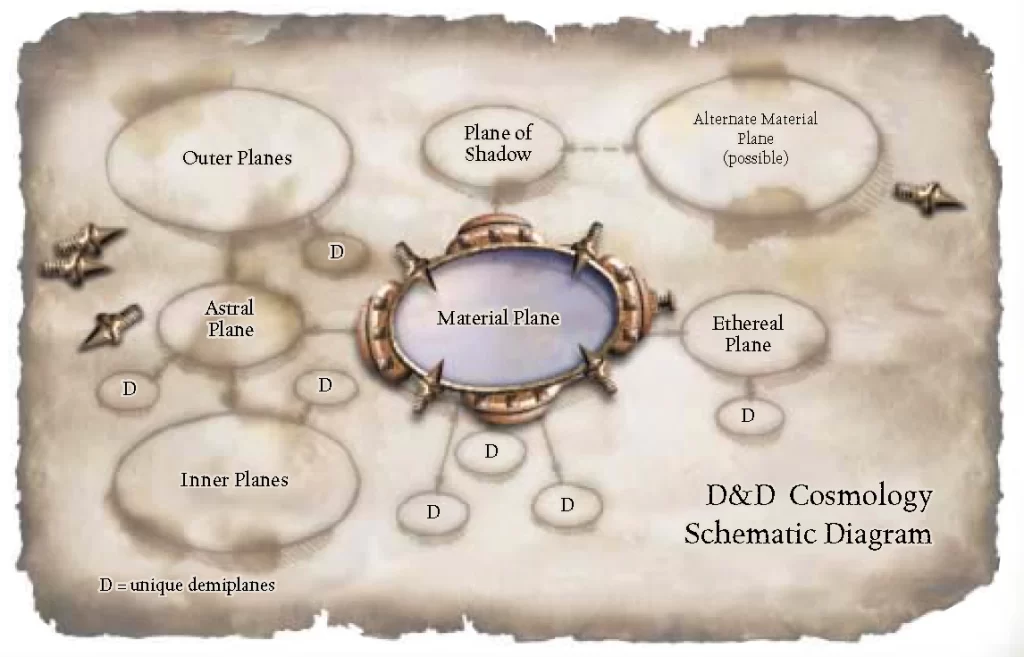
The world in which the characters live is only one of many worlds in their infinite universe; the possibilities for "normal" adventuring in the multiverse are limitless. But the fantasy role-playing game involves other places and things not found in the "normal" world; the 3-dimensional universe is only a small part of reality! There are many other places waiting to be found. The most common beyond the Prime Plane (the "normal" universe) are the other Planes of Existence.
Think of the entire normal universe as only one page in a large book. Two pages next to each other are touching, but are separate and entirely different. Moving across one page doesn't take you to the next one; you must go in a different direction altogether. In a similar manner, many Planes exist, and magic is needed to travel from one Plane to another. The whole of existence, including all the Planes is called "the Multiverse."
Nearby Planes
Most of a Campaign takes nearby place in a fantasy world similar to our own medieval times. That planet, and the whole of that universe, is called the Prime Plane.
One other Plane touches the Prime Plane, the Ethereal Plane, also called "the Ether." Travel to or through it requires magic. The "distance" to it cannot be measured in feet or miles; it is a magical distance, in a magical direction.
A potion or armor of ethereality allows the user to enter, travel in, and leave the Ethereal Plane. Many strange monsters wander through the Ether, including banshees, ghosts, and poltergeists.
The four Elemental Planes of Air, Earth, Fire, and Water are "near" the Prime Plane (as magical distances are measured), but do not touch it like the Ether does. To reach an Elemental Plane, a hole must be opened in the Prime Plane, and a tube must be created through the Ether, leading to the Elemental Plane. The hole is called a vortex, and the tube is called a wormhole.
Vortexes and wormholes can be created by gate spells, and can be made permanent with wishes. Several of these permanent worm holes connect the Elemental Planes with the Prime Plane, and elemental material is constantly flowing between the Planes. This movement creates wind, ocean currents, volcanos, and occasional earthquakes.
Distant Planes
Experienced travelers of the distant planes from the Prime Plane refer to the Prime, Ethereal, and Elemental Planes as the Inner Planes, for there are many other Planes of Existence. The Inner Planes are surrounded by the Astral Plane, which can be reached from either the Elemental or the Ethereal Planes.
Think of the Inner Planes as a group of islands in a vast ocean; this ocean is the Astral Plane. It is similar to the Ether, but much larger. Across the "Astral Ocean" are the Outer Planes, the homes of the Immortals and other strange creatures. The Outer Planes, and methods of visiting them, will be described later.

lnterplanar Adventures (traveling between two planes)
General Notes
Visualizing: When you describe a dungeon room or corridor to the players, they can usually imagine what it looks like. The characters' surroundings are always made of normal matter. Air exists, and can be breathed. Gravity exists, providing "up" and "down." These things rarely change, and the players can accurately "visualize" where their characters are, what they are doing, and what their surroundings are like.
The hardest part of adventuring in other Planes is visualizing what they are like.
An adventure in a wormhole is much like a dungeon adventure, merely vertical instead of horizontal. Air exists, and the flow through the wormhole provides a gravity of sorts. Thus, the DM and players can gradually become used to elemental adventures by exploring the wormholes, leaving the Planes until ready for them.
Time: Time passes on the Ethereal and Ele mental Planes just as it does on the Prime Plane. For example, if adventurers explore wormholes and other nearby Planes for a week, then a week will have passed on the Prime Plane when they return. However, time may pass at different rates-slower, faster, or not at all!-on more distant Planes.
Gravity: The pull created by very large masses, exists normally on the Elemental Planes, but is somewhat different on the Ethereal Plane. Creatures in the Ether are not affected by gravity, but can sense the pull of gravity on the nearby Prime.
The Ethereal Plane
A character's first experience with another Ethereal Plane will probably be a short trip into the Ethereal Plane.
Ether, the material of the Ethereal Plane, appears to be a gray fog in its normal form. If compressed (either by a creature or by magic), it is a sticky gray solid.
Any ethereal creature can sense the direction of gravity on the Prime Plane, but is not affected by it. Thus, while ethereal, a character knows the direction of "down," but can not fall.
Vision
When on the Ethereal Plane, vision is nor mal, with the same range as in a dark under ground corridor. Except for creatures, everything is the same color (gray fog) and temperature (about 50 degrees Fahrenheit), so infravision is nearly useless. All light sources function normally (a torch or lantern shining light to 30' range, magical light to greater ranges, etc.), but they only light the Ether, not reaching into wormholes or into the Prime Plane.
An Ethereal traveler cannot see into the Prime Plane unless a detect invisible spell (or similar magical effect) is used. However, the gray fog of the Ether may be dense or thin, varying by what is nearby on the Prime Plane. Nearby water appears as dark Ether, and rock, earth and wood as even thicker Ether.
Dense rock and heavy metals (lead, gold, etc.), appear as solid Ether (ectoplasm). Fire on the nearby Prime Plane appears as bright Ether. By noting these changes of density (which affect Ethereal movement), a traveler can tell what the conditions are nearby on the Prime Plane, or can at least make a good guess.
Movement
Usually without magical movement capability, a visitor to the Ether cannot travel. A fly spell allows normal movement (120' /round); a potion or armor of ethereality gives the same rate of travel as flying. Thus, a traveler moves through the Ether at the following rates, varying by conditions on the nearby Prime Plane:
Vacuum 240' /round (double normal) Air 120'/round (normal)
Fire or Water 90' /round (3/4 normal) Soil, Wood 60' /round (1/2 normal) Rock 30' /round (1/4 normal) Metal 0 Lead 0

Elemental Planes
Use the following general guidelines to create adventures on and involving the Elemental Planes. Be sure to review the "Elemental Magic" section.
Each Elemental Plane is a universe much like the Prime, but all the material is a single element. The elemental matter collects in clumps (planets, moons, etc.); it can exist in solid, liquid, or gaseous form. The strange creatures of the Elemental Planes are mixtures of solid and liquid material, held together by a life force of thought and energy (much like creatures on the Prime Plane).
When a planet exists on an Elemental Plane in roughly the same "position" as a planet on the Prime Plane, natural vortexes and wormholes appear, connecting the planets on each Plane. Thus, for the "normal" fantasy role-playing world, there are four other planets in similar positions, one on each of the Elemental Planes. Other planets in the Prime universe might not have corresponding Elemental planets; another world might thus be missing one or more elements.
Moons, comets, and other large moving bodies on the Prime Plane rarely have any elemental connections. They are sometimes created by temporary wormholes, which break when the corresponding body on the Elemental plane moves out of position. In a similar manner, a vortex may suddenly appear on a moving body, as a corresponding moon "nears it" on the Elemental Plane. For example, an ocean could suddenly appear on a moon near the characters' world!
Some creatures of the Elemental Planes are described in Part 2 of the "Monsters" section (pages 38-42). You may construct whole civilizations, as interesting and complex as those on the characters' world, with that information. Adventuring can proceed much as it always has, but with entirely new settings, encounters, and even new treasures.
Vortexes and Wormholes
A vortex is an invisible hole in a Plane, with elemental matter either whirling into or erupting out of it. A current of elemental matter flows in one direction, to or away from the elemental plane.
If seen by a detect invisible spell or similar magic, it appears as a shimmering-colored circle from the front or back-but cannot be seen at all from the side; it has no thickness. On the Prime Plane, the color of the vortex matches the Plane to which it leads-blue for Air, brown for Earth, red for Fire, and green for Water.
Other colors match other more dis tant Planes. On other Planes, a vortex leading to the Prime Plane is a multi-colored swirl of the four elemental colors. A vortex may appear to float in the air or lie on a surface. A natural elemental vortex is always located in the element corresponding to its destination (whirlpool, volcano), but a created vortex (by a gate spell) may appear anywhere.
A wormhole is a connecting passage between Planes. It is simply a round tube with wrinkled sides, appearing very similar to a dungeon corridor but without any corners. However, a wormhole seems to be a vertical passage, rather than horizontal, because of the current through it. 1ravelling in the wormhole with the current is easier than travelling against it.
A wormhole is never straight, bending and winding along its entire length, thus its name. Many of the things inside a wormhole are made of elemental material (matching the Plane to which it leads), but other elements and creatures are often present. Wormholes cannot be seen from the Prime Plane, and only the outside can be seen from the Ether. The outer surface looks like a wrinkled, lumpy gray tube; it is sticky. The surface is actually made of ectoplasm (solid ether), compressed by the magic needed to create the wormhole. Wormholes vary in size, from a thick string size to a pillar or slightly curved wall.
Each wormhole is usually 10 miles long or more. The network of permanent wormholes between the Prime and Elemental planes looks similar to the roots of a plant; each small wormhole joins a larger one, until all the smaller wormholes connect to one huge wormhole connected to the Elemental Plane itself.
Creatures and things in a wormhole are magically changed into the "proper" element when they reach the Elemental Plane, unless protected by powerful magic.
The Campaign
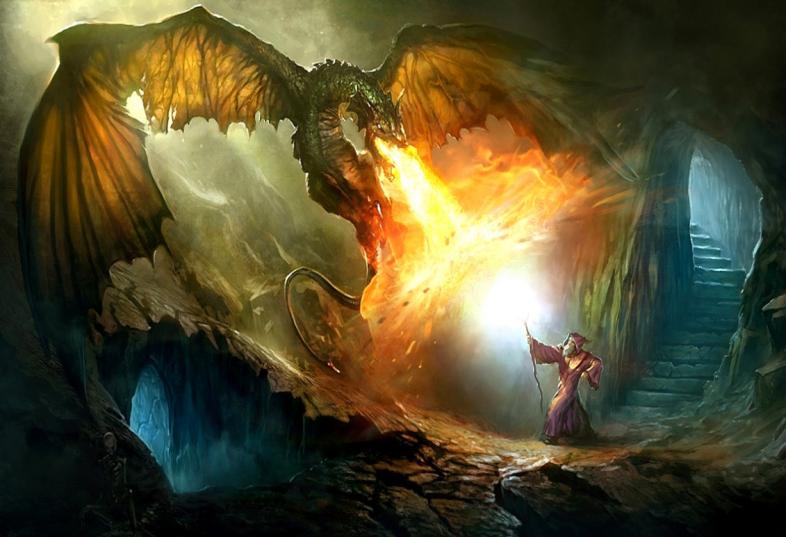
The following notes apply only to the Inner Planes. The Astral and Outer Planes cause other changes in magical effects, because of their differing natural laws. More information is given later.
In the fantasy role-playing, magic on the Prime Plane is a highly developed art. However, magic as the characters know it was created in a unique setting-the Prime Plane, an odd mixture of all four elements. This situation is not found in any other Plane of the multi verse!
Some magical effects are not based on elements at all, but on Energy. Examples include most detect spells, cures, light and darkness, and lightning bolts. These effects will function "normally" (as they do on the Prime Plane) when used on any Inner Plane.
Other effects are partially or wholly based on matter, affecting it in various ways. These effects may be negated, partially changed, or completely different.
Beings of different elements affect each other in logical ways. The basic principles used are dominance and opposition. If one element has dominance over another, it has power over that element. If two elements are in opposition, they are enemies, but affect each other normally. The principles of dominance and opposition are easily summarized:
Air has dominance over Water.
Water has dominance over Fire.
Fire has dominance over Earth.
Earth has dominance over Air.
Air and Fire are in opposition.
Earth and Water are in opposition.
DOMINANCE - OPPOSITION
In combat between elemental beings, dominance and opposition have the following effects:
Dominance results in double damage; the victim may make a Saving Throw vs. Spells to take normal damage.
When one creature has dominance over another, it is less affected by the other's nor mal attacks. Only minimum damage may be inflicted. In Example #1 above, the water elemental's normal damage is 3-24 points, so only 3 points are inflicted on any successful hit. The victim of dominance tends to fear the other; if a Reaction Roll indicates hostility, "flee" should replace "attack."
Opposition results in hostility; a penalty applies to all Reaction Rolls. The penalty is-8 if the creatures are totally opposed (good vs. evil), or -4 otherwise.
When two creatures are in opposition, no change in damage occurs; only reactions are affected. The creatures' reactions to others are not affected; the penalty applies only to reactions to the creature of opposition.
Example #1: A party is attacked by a fire elemental, so their magic-user casts a conjure water elemental spell. Each blow from the resulting water elemental inflicts double damage to the fire elemental, but it may make a Saving Throw (per blow) to take nor mal damage.
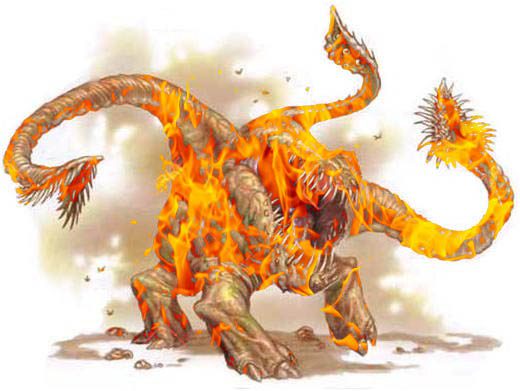
Example #2: A Djinni (good) meets an Efreeti (evil); each has a -8 penalty to all Reaction Rolls.
Example #3: A Kryst meets an Undine (both good); a -4 penalty applies to all their Reaction Rolls.
Notes on Spells
The spells learned on the Prime Plane usually function normally on the Ether and on the Elemental Planes unless affected by dominance or opposition (see above). Most spells can easily be translated by replacing the terms "stone" with "solid element," "water" and liquids with "liquid element," and "flesh" with "solid/liquid element."
Spell-using creatures native to other Planes know "local" versions of many spells. These spells include the clerical barrier, cre ate water, and resist fire spells, and the magic-user charm person, cloudkill, fire ball, delayed blast fire ball, ice storm/wall, lower water, magic missile, massmorph, move earth, pass-wall, statue, water breathing and web spells, and all wall spells.
A visitor from the Prime Plane could learn the "local" version of these spells, if taught by a friendly resident. However, local ele mental versions of spells will work only on the same plane; a flesh to ice learned on the Plane of Water would have no effect if attempted on any other Plane, including the Plane of Fire (despite dominance).
Spells with Limited Effects
Druid spells are useless on any Plane but the Prime; they are based entirely on knowledge of Nature as it exists on the Prime Plane. A cleric's create normal animals has no effect on an Elemental Plane unless the local versions of animals are well-known. A cleric's aerial servant has no effect on the Plane of Air, but functions normally elsewhere; the same applies to the invisible stalker magic-user spell. Weather control has no effect on any Plane but the Prime.
Prime Plane insect-based spells will not work on any other Plane.

